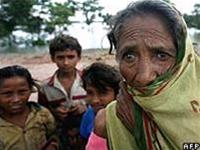South Asia flood victims face
Millions of people affected by floods in South Asia are facing a health crisis if their relief is not pushed faster, warns the United Nations.
According to the World Health Organization (WHO) and the United Nations Children's Fund (UNICEF), stagnant water is becoming a deadly disease-producing region such as malaria and dengue fever.
Food, drinking water and medicines are being distributed to affected areas, however, due to large-scale natural disasters, relief efforts have become " impervious ". "Many villages are under threat from a health crisis if people can't reach them in the next few days," said Dr. Marzio Babille, UNICEF president in India.

According to WHO and UNICEF, millions of people affected by floods in South Asia are facing a health crisis if their relief is not pushed faster (Photo: AFP)
'Flooded water is becoming a place to produce diarrhea and waterborne diseases', he said, adding that children, accounting for 40% of South Asia's population, are subject to serious threats. Most important.
To date, there are about 28 million people affected by floods in India, Bangladesh and Nepal. India is the worst affected country, with about 20 million people in the states of Assam, Bihar and Uttar Pradesh affected. In Bangladesh, this figure is 8 million and in Nepal is 300,000.
In Nepal and Bangladesh, although the water level has decreased, there are still millions of people isolated on high lands.
Yesterday (August 7), Indian Interior Minister Shivraj Patil and National Party President Sonia Gandhi visited Bihar state, where the worst hit, amid rising anger in the people due to rescue. slow support.
In this state, there are about 7 million people affected by the flood and according to reports, fighting incidents have occurred to fight limited aid.
WALL VY
- South Asia is submerged in flood waters
- Japan supports Southeast Asian countries against flood and storm
- 8,000 people were killed in flooding in India
- Heavy flooding in South America, many people died
- Discovered 'dead zone' at earthquake epicenter in South Asia
- New flooding is not caused by 'Mr. heaven'
- UNICEF: HIV / AIDS affects 10 million children in South Asia
- Unique, monkey face orchid flowers in South America
- Long flood in Thailand, 107 people died
- Asian cities continued to suffer disaster
- Central Vietnam overcomes flood, the North receives a new cold wave
- Floods washed away 13 houses with 12 people
 Is the magnetic North Pole shift dangerous to humanity?
Is the magnetic North Pole shift dangerous to humanity? Washington legalizes the recycling of human bodies into fertilizer
Washington legalizes the recycling of human bodies into fertilizer Lightning stone - the mysterious guest
Lightning stone - the mysterious guest Stunned by the mysterious sunset, strange appearance
Stunned by the mysterious sunset, strange appearance